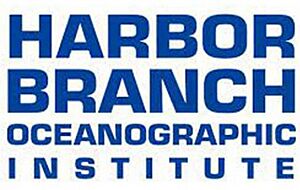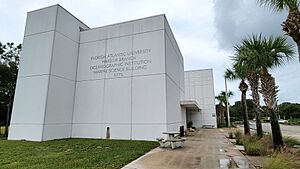Harbor Branch Oceanographic Institute facts for kids
The Harbor Branch Oceanographic Institute (often called HBOI or FAU Harbor Branch) is a special place in Fort Pierce, Florida where scientists study the ocean. It's part of Florida Atlantic University. HBOI started in 1971 as a non-profit group, and in 2007, it joined FAU.
Contents
History of HBOI
How it Started
HBOI began in 1971. It was first called the Harbor Branch Foundation. J. Seward Johnson, Sr. and Edwin Albert Link created it. They wanted a place for ocean research. Later, its name changed to Harbor Branch Oceanographic Institution.
Amazing Submersibles
Edwin Link helped build special deep-sea submersibles. These are like small submarines for science. They were called the Johnson Sea Link. The first one, Johnson Sea Link I, was built in 1971. It was an improved version of Link's earlier submersible, Deep Diver. Johnson Sea Link II was built in 1975. These submersibles helped scientists explore the deep ocean.
Joining Florida Atlantic University
In December 2007, HBOI became part of Florida Atlantic University (FAU). This helped HBOI continue its important research. The original HBOI group then became the Harbor Branch Oceanographic Institute Foundation. This foundation still helps support the institute today.
Exploring the HBOI Campus
HBOI is located on a 144-acre campus. It sits along the Indian River Lagoon in Florida. This area is a special estuary, where fresh and salt water mix. The campus has 32 buildings. Over 150 scientists and staff work there. It is the northernmost campus of Florida Atlantic University.
Ocean Research and Learning
HBOI focuses on many areas of ocean science. They study ocean life, from estuaries to the deep sea. They also work on aquaculture, which is like farming in the ocean. Scientists at HBOI look for natural products from the ocean that could become new medicines. They also design new ocean tools and technology.
More than 160 scientists, engineers, and mariners work at HBOI. They get money from grants and donations. This funding helps them do their important research.
Key Research Areas
HBOI does about one-third of all research at FAU. Here are some of their main research areas:
- Aquaculture & Stock Enhancement: Raising marine animals and plants.
- Marine Biomedical & Biotechnology Research: Finding new medicines from the ocean.
- Marine Ecosystem Health: Keeping ocean environments healthy.
- Ocean Dynamics and Modeling: Understanding how oceans move and change.
- Marine Science Education: Teaching people about the ocean.
- Ocean Engineering & Technology: Building new tools for ocean exploration.
Harbor Branch Ocean Discovery Center
The Harbor Branch Ocean Discovery Center is a fun place for everyone to visit. It is open to the public in Fort Pierce, Florida. You can see interactive exhibits about the ocean. There are also live marine creatures and a video theater. Displays show the amazing research done at HBOI. The Center is closed on Sundays and major holidays.
Marine and Oceanographic Academy
Since 2007, HBOI has been home to a special high school program. It's called the Marine and Oceanographic Academy (MOA). This program is for students from across St. Lucie County. It teaches regular high school subjects but with a focus on marine science.
Amazing Discoveries and Help
HBOI has been involved in many important projects:
- Their Johnson Sea Link submersibles made over 9,400 dives. They collected thousands of marine sponges and tiny creatures. These collections help scientists study ocean life.
- HBOI helped find the Space Shuttle Challenger rocket booster on the ocean floor. This discovery helped explain what happened in the 1986 accident.
- They examined the wreckage of the USS Monitor. This was an ironclad Civil War battleship that sank in 1862.
- HBOI assisted in the rescue of Winter in December 2005. Winter was a bottlenose dolphin who later became famous in the movie Dolphin Tale.






